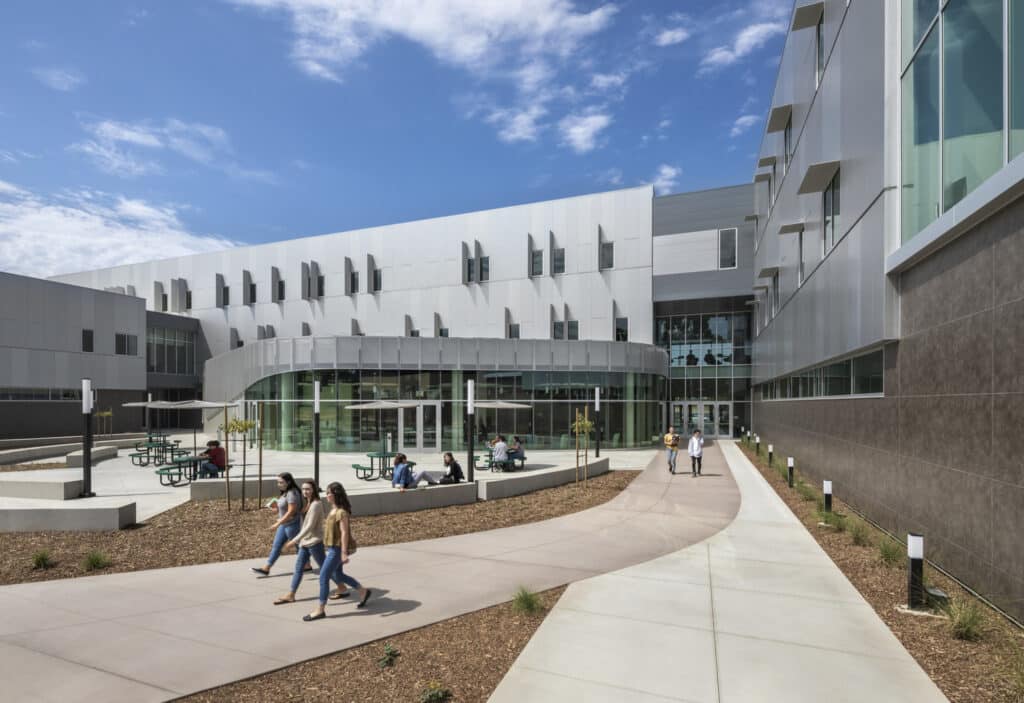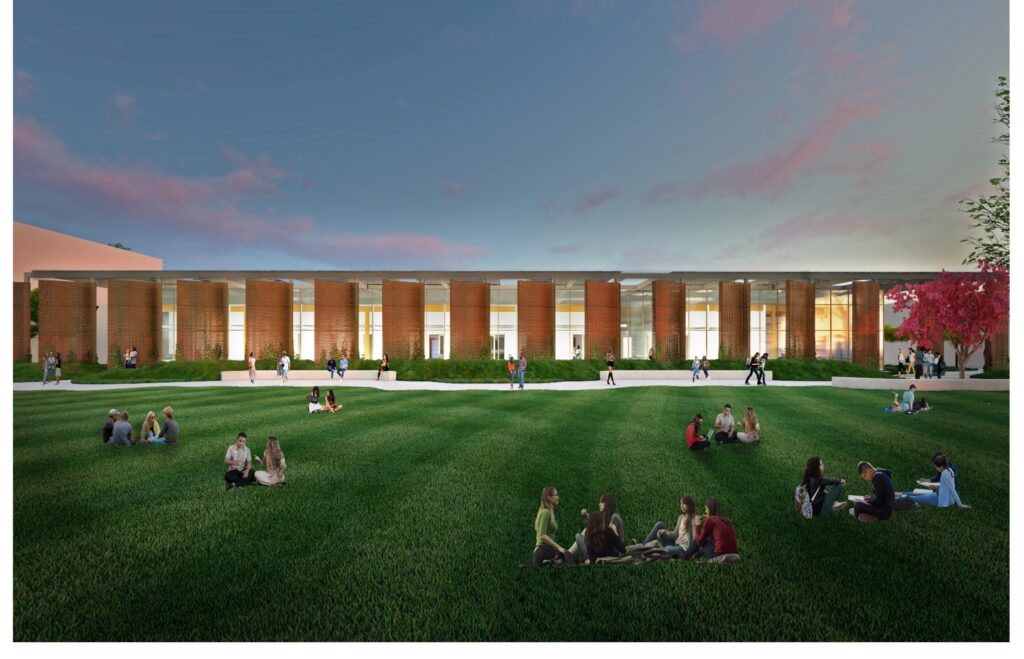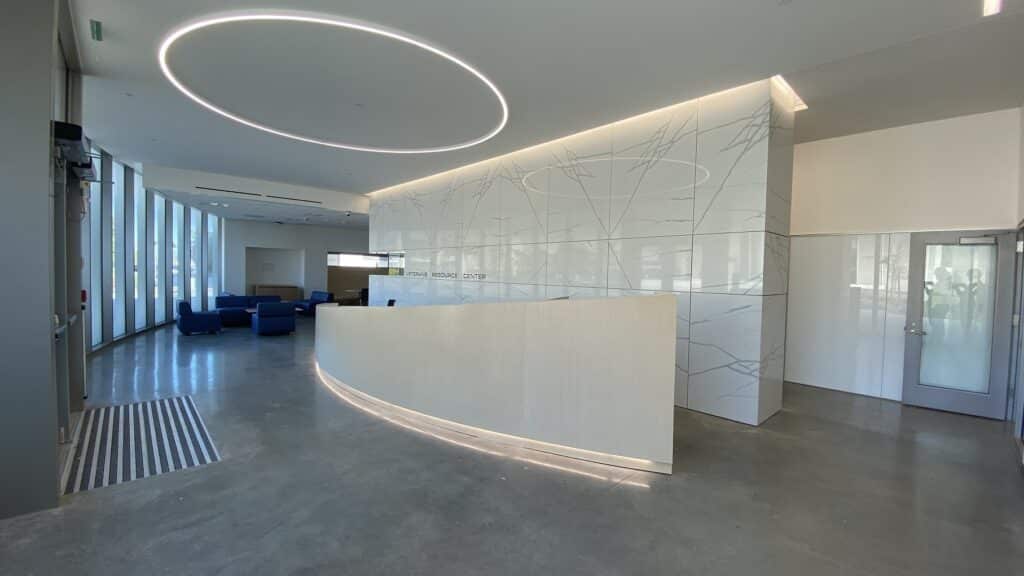Community colleges have long served as a bridge to skilled careers and livable wages. Research shows that California community college graduates nearly double their earnings within three years. The thing about bridges is, over time, they need upgrades: stronger substructures, added lanes, and multimodal pathways to accommodate more users. The same concept applies to buildings and infrastructure on college campuses. But bridging the equity gap laid bare by the pandemic, while also redefining college education in a post-Covid world—that work is a lot more complicated.
California’s community college system enrolls roughly 2 million full- and part-time students, making it the largest system of higher education in the country. All 73 districts continue to deal with challenges from Covid-19, with most seeing a decline in enrollment from 2019 to 2020. Re-engaging students, expanding access to technology, and, as students return, creating sustainable campus environments are all top of mind as summer approaches. For district leaders planning new construction, it’s critical that their design and construction partners understand these needs.

Student Success Starts with Student Access
“Using public funds to do the most public good possible is the idea behind the community college model, and that’s here to stay,” said Project Director John Messick of Sundt’s Building Group, California District. “The way that districts accomplish that, however, is evolving pretty rapidly due to factors like the pandemic, big data and climate change.”
One example of this evolution is at Southwestern College in Chula Vista, where Sundt is serving as the construction manager at risk (CMAR) for a new Institutional Technology Building set to break ground this summer. The 18,500-square-foot project will include a new data center as well as offices and conference room space for instructional and IT staff. The building is designed to achieve net-zero energy use and includes a roof-mounted PV solar system.

“This facility is going to be state-of-the-art, like something you’d see on Google’s campus,” said John. “Picture glass curtain walls, exposed glulam beams, architectural tilt-up panels, and a full rooftop solar array.” While much of the building’s interior will remain behind the scenes from students, the technology and staff here will help connect them to a better learning experience.
Additional uses include network spaces, AV build-up, applications and research, and planning operations with helpdesk and desktop support. Southwestern College has recently launched multiple efforts to expand student access, including its Virtual Desktop Infrastructure (VDI) system which allows students to utilize lab apps and software remotely, as if they were actually on campus.
“The pandemic has revealed and, in some ways, widened the equity gap among different groups of students,” said John. “A big part of overcoming that gap is building infrastructure like this for more access and support, whether for remote, in-person, or hybrid learning.” Sundt has experienced project teams in technology- and STEM-focused higher ed projects, and has the added advantage of market expertise in data centers and utility-scale PV solar projects as well.
Lasting Relationships Start with Good Stewardship
As community college districts navigate one of the most critical junctures in their history, administrators and trustees are looking for the best return on investment possible. Campuses are slowly returning to more in-person learning, especially in areas where hands-on instruction is essential such as CTE and allied health fields. The need for more energy-efficient, high-quality buildings with predictable project outcomes and minimal disruptions to campus operations has become all the more significant.
Having completed over 200 projects for colleges and universities, Sundt is a known leader in higher ed construction throughout California. Our relationships and repeat work within the UC, CSU, and CCC systems come back to the level of trust that our project teams have earned, beginning with our stewardship of the natural environment and of the public funds and campus environments entrusted to us.

According to Project Director Betty Lynn Senes, LEED AP and DBIA Western Pacific Region board member, today’s higher ed builders need to operate with an understanding of the why behind sustainability as well as the how. “With the rate our climate is changing, we have a moral imperative—not just a fiscal or regulatory imperative—to build sustainable and long-lasting buildings. Once that’s understood, it takes a holistic vision and team-based approach.” From early on in each project, Betty Lynn explained, our teams work to understand every building system, as well as how all of those systems interact. “We do this best through alternative delivery methods where all stakeholders are collaborating from day one.”
In community college construction, Sundt’s reputation as a sustainable builder is tied to our reputation as a collaborative builder. “What it really comes down to is: we care,” said Betty Lynn. “We care about the learning outcomes of these students, and the opportunity gap that our work is helping to close. So, the need to ‘get it right’ outweighs the need to ‘be right’ in the kinds of project environments that our employee-owners create. And I think clients value that.”

It’s not by accident that Sundt has won repeat work with community college districts across California including San Diego, Coast, Yuba, North Orange County, and Foothill-De Anza. “We’re familiar with the needs and demands placed on students, and the people who serve them,” said Betty Lynn. “We don’t have a crystal ball to see the exact future of this market. But we do know that our communities need these colleges now more than ever, and we’re here to support their mission.”